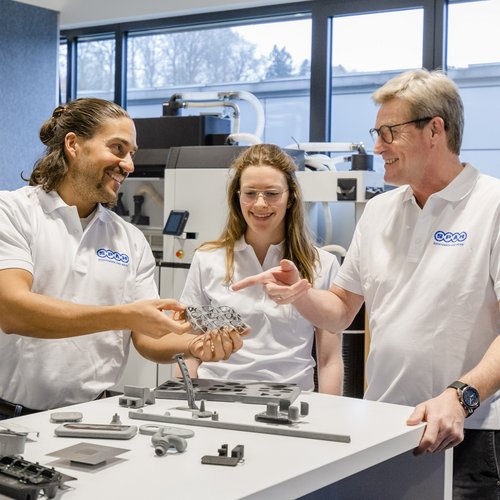
Industrial 3D printing: the start of a new era in manufacturing?
As a leading, pan-European expert in rubber and plastics processing, the SPÄH Group offers a wide range of machining processes, large warehouse capacities, and a virtually endless assortment of materials. SPÄH is also among the most innovative companies in the field of additive manufacturing. In our interview, members of our Additive Manufacturing business unit bring us up to speed on this exciting development.
For which industries are 3D-printed components suitable?
C. Schuler: “In principle, they can be used in any sector: from industry, medical technology, capital goods, and seals to furniture manufacturing. Depending on the desired material, the individual products are weather-resistant as well as UV-resistant, sturdy and impact-resistant. In addition to polyamide 12 (PA12), we also offer a special combination of MJF technology and polypropylene (PP).”
What are the characteristics of industrial 3D printing?
B. Rath: “A characteristic feature is that the components are manufactured with almost no restrictions in terms of geometry – the only limiting factor is the available installation space. The goal of additive manufacturing is to create added value for our customers, which can then translate into material, weight and cost reductions of up to 50% via design adaptations. Design changes are also possible during ongoing series production. Depending on the component, quantities of 20,000–50,000 pieces/year are worthwhile.
Can additive manufacturing compete with conventional manufacturing processes?
R. Fischer: “Additive manufacturing is increasingly being seen as a complement to conventional production processes. It’s competitive thanks to the potential for design-related optimizations, the lack of setup and tooling costs, and the use of lower-cost materials. We have achieved weight reductions of up to 60% through material savings and material changes – with improved functionality and unchanged rigidity.”
Is additive manufacturing a sustainable process technology?
R. Fischer: “A resounding yes. As a production process, it already has some sustainable characteristics. For example, 100% of the extracted base material is reused with the addition of virgin material. Other aspects include regional procurement, shorter delivery times, short transport routes and reduced inventories (on-demand production). This leads to an improvement of the carbon footprint in the long term.
Photo: SPÄH Additive Manufacturing business unit, from left to right:
R. Fischer (Business Unit Coordinator), C. Schuler (Sales Administrator) and B. Rath (Business Unit Coordinator)